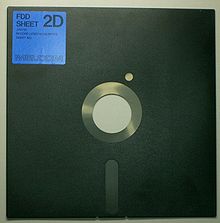Floppy disk
From Wikipedia, the free encyclopedia
The floppy disk (or a 3½ floppy for today's standard) is a removable magnetic storage medium. Floppy disks are used for moving information between computers, laptops or other devices. Some early digital cameras, electronic music instruments and older computer game consoles use floppy disks. Floppy disks are inserted in to a floppy disk drive or simply floppy drive to allow data to be read or stored.
Floppy disks store much less data than a CD-ROM disk or USB flash drive. A normal 3½ inch disk can store 1.44 megabytes of data. This is usually enough for simple text documents.
A special type of floppy disk was made in the late 1980s. It could store 2.88 MB of data. They did not become popular. Larger size floppy disks became available in the 1990s. The 2 most popular were the Zip drive and the Jaz drive, both made by Iomega.
Floppy disk technology has been around since the early 1970s (the 8-inch floppy was the first). Today, floppy disks have been replaced by other storage media, like USB flash drives.
The floppy drive[change | change source]
A floppy drive (often called drive “A” on a computer) can be connected to or installed in a personal computer (PC). It is the part of a computer that reads and writes the disk that can be removed. A disk, often called a floppy disk, is used to store files and carry them from one computer to another by using the floppy drive. The floppy drive reads the disk (or diskette) and the user is then able to open and change the files saved on the disk.
Capacities[change | change source]
| Floppy disk format | Year introduced | Storage capacity (binary kilobytes if not stated) | Marketed capacity |
|---|---|---|---|
| 8-inch (read-only) | 1969 | 80 | ← |
| 8-inch | 1972 | 187.5 | 1.5 Mbit |
| 8-inch | 1973 | 256 | 256 KB |
| 8-inch DD | 1976 | 500 | 0.5 MB |
| 5¼-inch | 1976 | 223 | ← |
| 8-inch double sided | 1977 | 1200 | 1.2 MB |
| 5¼-inch DD | 1978 | 360 | 360 KB |
| 3½-inch HP single sided | 1982 | 280 | 264 KB |
| 3-inch | 1982? | 360? | ← |
| 3½-inch (DD at release) | 1984 | 720 | 720 KB |
| 5¼-inch QD | 1984 | 1200 | 1.2 MB |
| 3-inch DD | 1984? | 720? | ← |
| 3-inch Mitsumi Quick Disk | 1985 | 128 to 256 | ← |
| 2-inch | 1985? | 720? | ← |
| 5¼-inch Perpendicular | 1986? | 100 MiB | ← |
| 3½-inch HD | 1987 | 1440 | 1.44 MB |
| 3½-inch ED | 1991 | 2880 | 2.88 MB |
| 3½-inch LS-120 | 1996 | 120.375 MiB | 120 MB |
| 3½-inch LS-240 | 1997 | 240.75 MiB | 240 MB |
| 3½-inch HiFD | 1998/99 | 150/200 MiB? | 150/200 MB |
| Acronyms: DD = Double Density; QD = Quad Density; HD = High Density ED = Extended Density; LS = Laser Servo; HiFD = High capacity Floppy Disk | |||
Dates and capacities marked ? are of unclear origin and need source information; other listed capacities refer to:
Other formats may get more or less capacity from the same drives and disks.
| |||




No comments:
Post a Comment